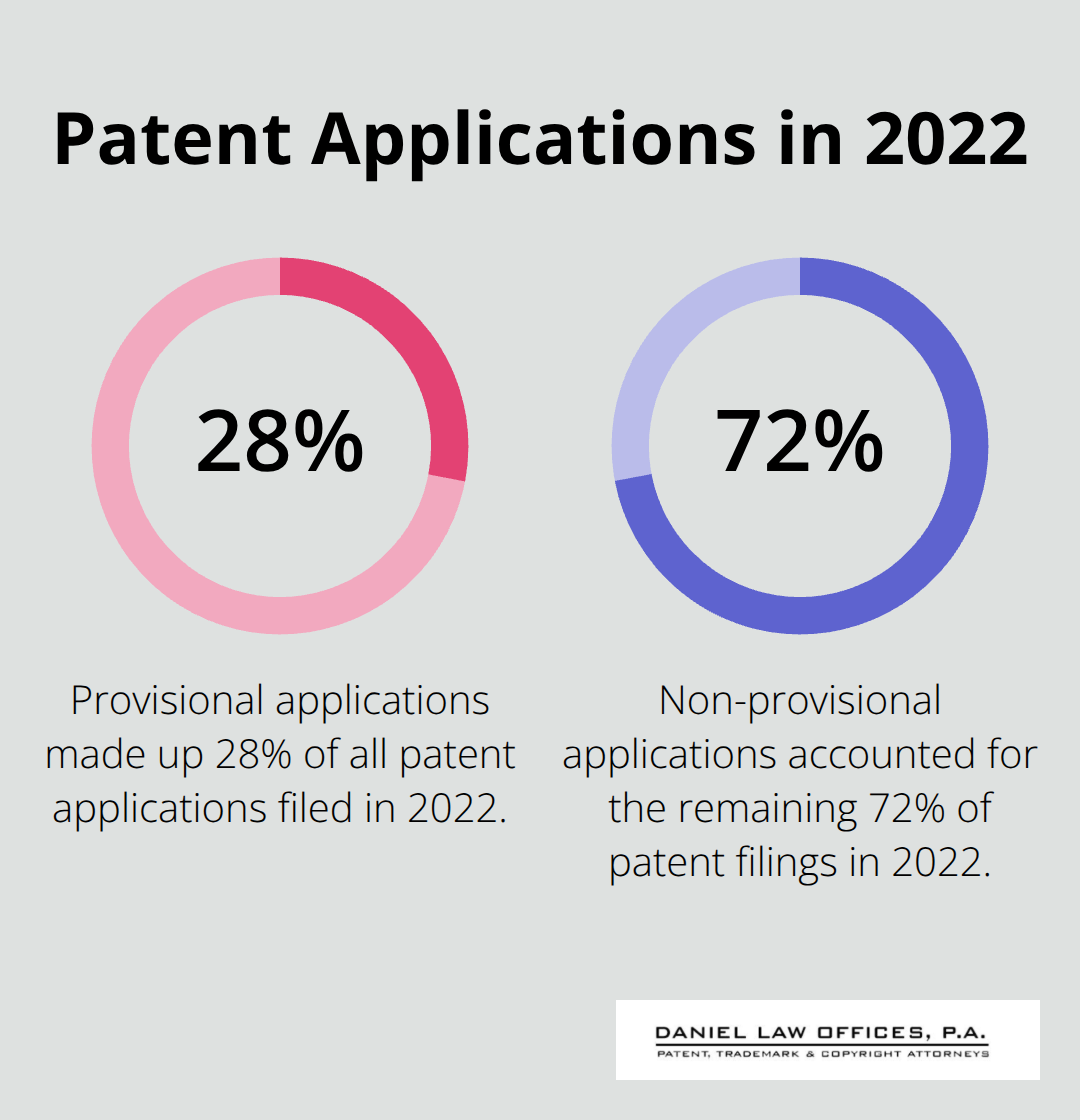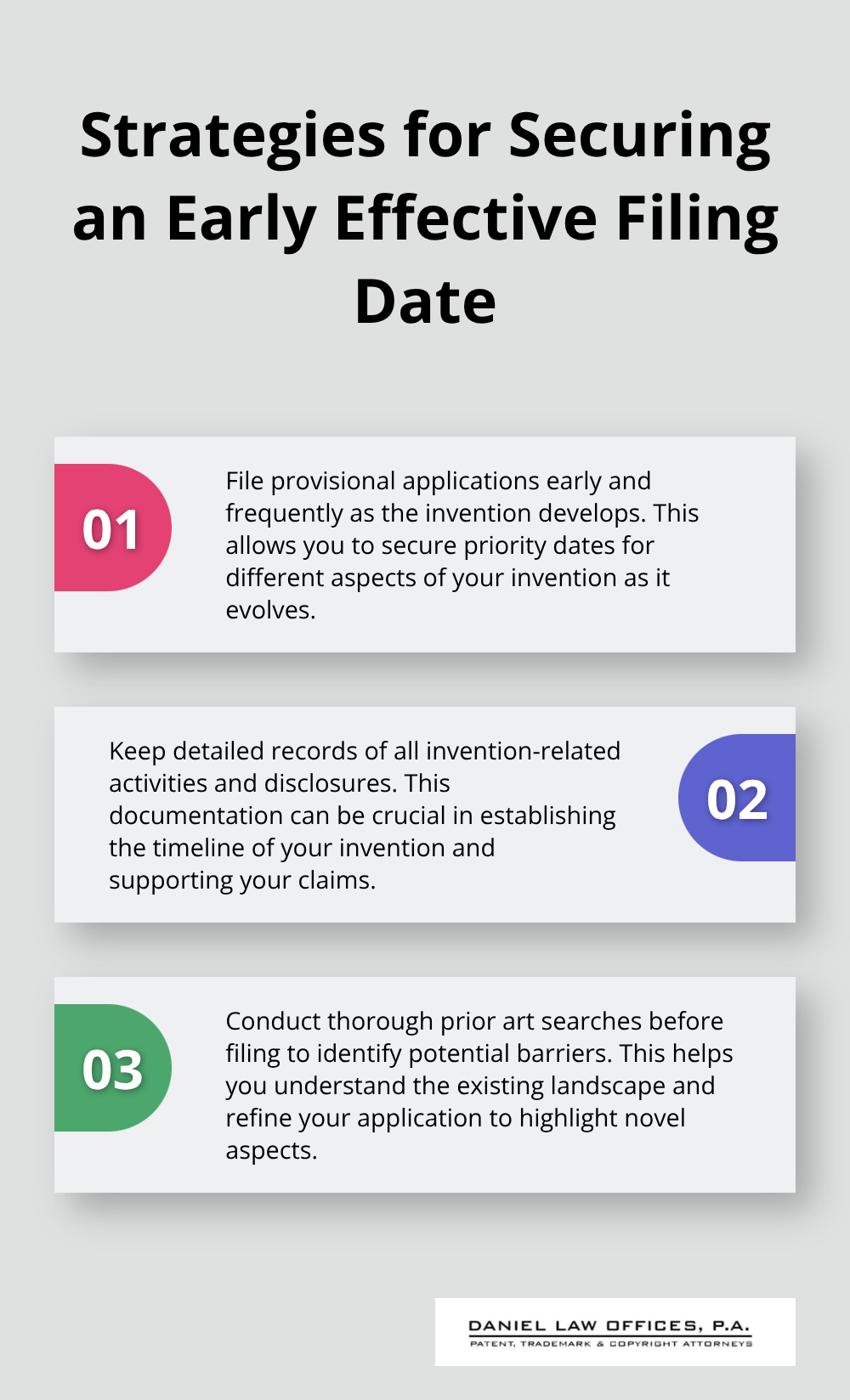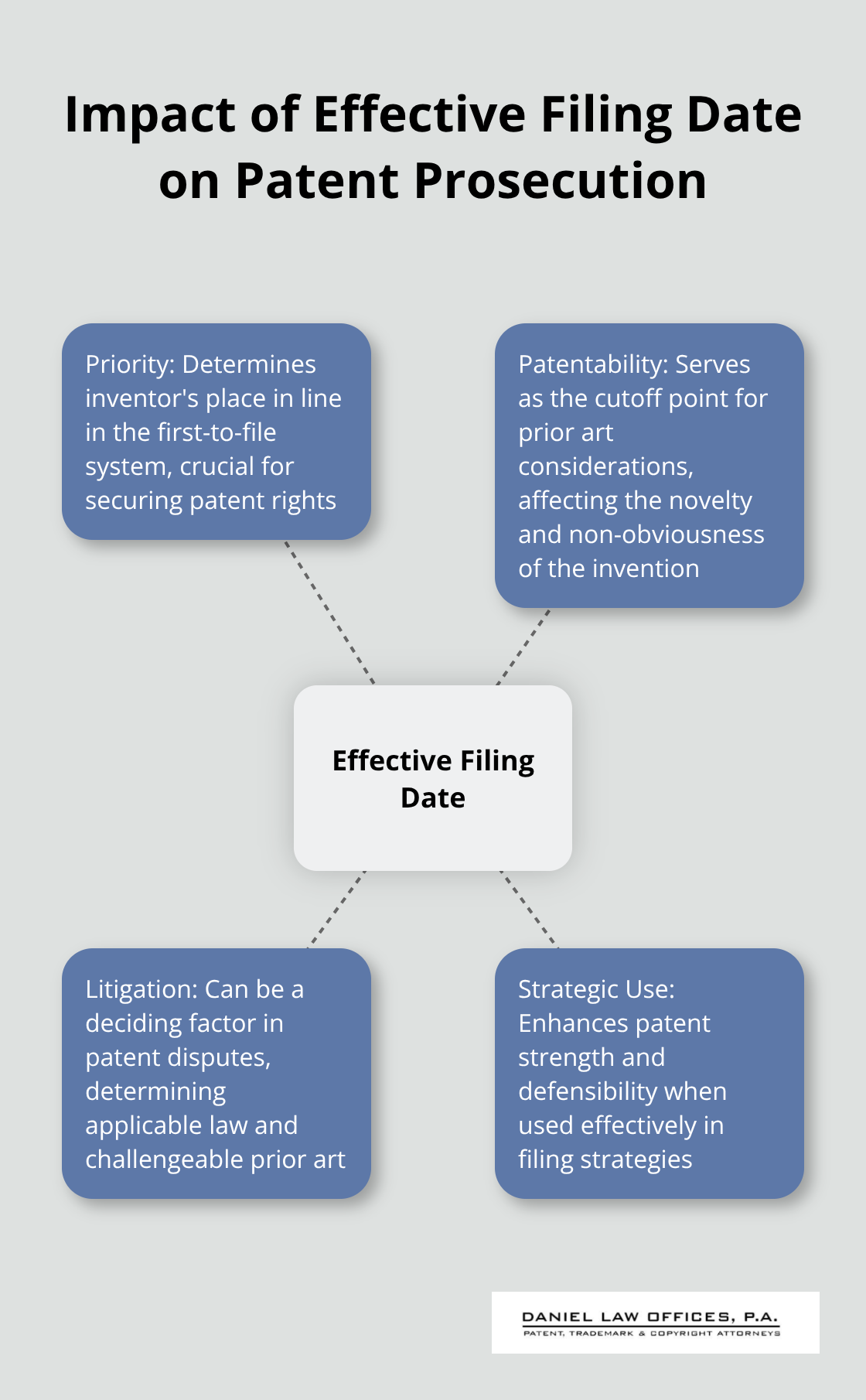Understanding Effective Filing Date in Patents in Orlando, Florida
The effective filing date of a patent is a critical concept in intellectual property law. It determines when an invention is considered to have been officially disclosed, affecting its patentability and protection.
At Daniel Law Offices, P.A., we understand the complexities surrounding effective filing dates and their impact on patent applications. This blog post will explore the nuances of effective filing dates, their significance in patent prosecution, and how they can influence the outcome of your patent journey.
What Is an Effective Filing Date?
The Foundation of Patent Protection
The effective filing date stands as a cornerstone of patent law. It marks the official start of an invention’s protection. The United States Patent and Trademark Office (USPTO) recognizes this date as the earliest for a patent application, which can significantly impact the outcome of patent rights.
The Impact on Patent Rights
An effective filing date functions as a timestamp for an invention. The USPTO uses this date to determine if an invention is new and non-obvious compared to existing technology. This date establishes an inventor’s place in line among others who might have similar ideas.
USPTO statistics reveal that in 2022, inventors filed over 600,000 patent applications. With such high numbers, a single day can make a difference in securing intellectual property rights.
Distinguishing from Other Patent Dates
The effective filing date differs from other important dates in the patent process. While the application filing date represents when an inventor submits a patent application to the USPTO, the effective filing date might be earlier if an inventor claims priority from a provisional application or a foreign filing.
Practical Strategies for Early Effective Filing Dates
A well-planned filing strategy can make or break a patent application. Here are some practical tips to secure an early effective filing date:
- File a provisional application promptly: This can provide up to a year to develop an invention further while securing an early filing date.
- Maintain detailed invention records: These records (including sketches, notes, and prototypes) can prove crucial if an inventor needs to establish a conception date in certain scenarios.
- Consider international filing strategies: The Patent Cooperation Treaty (PCT) allows inventors to file in multiple countries while maintaining a single priority date.
As we move forward, it’s important to understand how to determine the effective filing date accurately. This knowledge will help inventors navigate the complex landscape of patent law and secure their intellectual property rights effectively.
How Is the Effective Filing Date Determined?
The Importance of Provisional Applications
Provisional patent applications serve as a cornerstone in establishing an early effective filing date. These applications offer inventors a quick and cost-effective way to secure a priority date. However, inventors must convert provisional applications to non-provisional applications within 12 months to maintain their priority.
USPTO data reveals that inventors filed approximately 170,000 provisional applications in 2022. This high number (representing a significant portion of all patent filings) underscores the strategy’s popularity among inventors who seek to establish an early effective filing date.
Non-Provisional Applications and Priority Claims
Non-provisional applications undergo full examination by the USPTO and can claim priority to earlier filed provisional or foreign applications. The effective filing date traces back to the earliest application in the priority chain.
For instance, if an inventor files a provisional application on January 1, 2023, and then files a non-provisional application claiming priority to the provisional on December 31, 2023, the effective filing date for the non-provisional application becomes January 1, 2023.
Prior Art Disclosures and Their Impact
Prior art disclosures significantly affect the determination of the effective filing date. In the United States, inventors have a one-year grace period from their own public disclosures to file a patent application. However, third-party disclosures can immediately bar patentability if they occur before the effective filing date.
A World Intellectual Property Organization (WIPO) study found that approximately 30% of patent applications face rejections due to prior art issues. This statistic highlights the need for early filing and maintaining confidentiality before submission.

Strategies for Securing an Early Effective Filing Date
To navigate these complexities, inventors should consider the following strategies:
- File provisional applications early and frequently as the invention develops.
- Keep detailed records of all invention-related activities and disclosures.
- Conduct thorough prior art searches before filing to identify potential barriers.

The effective filing date plays a pivotal role in patent prosecution. Understanding its determination and impact can significantly influence the success of a patent application. The next section will explore how the effective filing date affects various aspects of the patent process, from prosecution to potential litigation.
How the Effective Filing Date Impacts Patent Prosecution
Priority in the First-to-File System
The effective filing date determines priority in the United States’ first-to-file system. This system has accelerated the patent filing process. USPTO data reveals that in 2022, the average time between invention disclosure and patent filing decreased by 15% compared to 2018. This statistic highlights the urgency inventors face to secure early filing dates.
Patentability and Prior Art Considerations
The effective filing date serves as the cutoff point for prior art considerations. Any public disclosure before this date can potentially invalidate a patent claim. A European Patent Office study found that 60% of patent rejections resulted from prior art issues (underscoring the importance of early filing).
To reduce these risks, inventors should:
- Conduct thorough prior art searches before filing
- File provisional applications early in the development process
- Maintain strict confidentiality until filing
Impact on Patent Disputes and Litigation
In patent litigation, the effective filing date can become a deciding factor. It determines which version of patent law applies to the case and what prior art can challenge the patent’s validity. The Federal Circuit Court of Appeals reported that in 2022, 35% of patent invalidation cases centered on disputes over effective filing dates.
To strengthen your position in potential disputes:
- Document all stages of invention development meticulously
- File continuation applications to capture new developments
- Consider international filing strategies to broaden protection
Strategic Use of Effective Filing Dates
The effective filing date is more than a calendar entry. It’s a strategic tool that can enhance the strength and defensibility of your patent when used effectively. Understanding its implications is essential for navigating the complex landscape of patent prosecution and litigation.
Practical Tips for Maximizing Effective Filing Dates
To maximize the benefits of effective filing dates, inventors should:
- File early and often (especially with provisional applications)
- Keep detailed records of all invention-related activities
- Stay informed about changes in patent law that might affect filing strategies
- Work with experienced patent professionals to develop a comprehensive filing strategy

Final Thoughts
The effective filing date patent concept stands as a cornerstone in intellectual property protection. It determines priority, assesses patentability, and establishes a strong defense against potential challenges. Inventors who understand this date’s significance gain a substantial advantage in the competitive landscape of innovation.
Early filing, meticulous record-keeping, and strategic use of provisional applications enhance an inventor’s position in the patent process. The first-to-file system in the United States emphasizes the importance of prompt action in securing patent rights. Inventors must act quickly to protect their valuable ideas and innovations.
Daniel Law Offices, P.A. recognizes the complexities surrounding effective filing dates and their impact on patent applications. Our team of professionals guides inventors through the intricacies of patent law (helping them navigate the challenges of securing and maintaining their intellectual property rights). We assist in developing comprehensive filing strategies to maximize our clients’ chances of success in the patent process.

